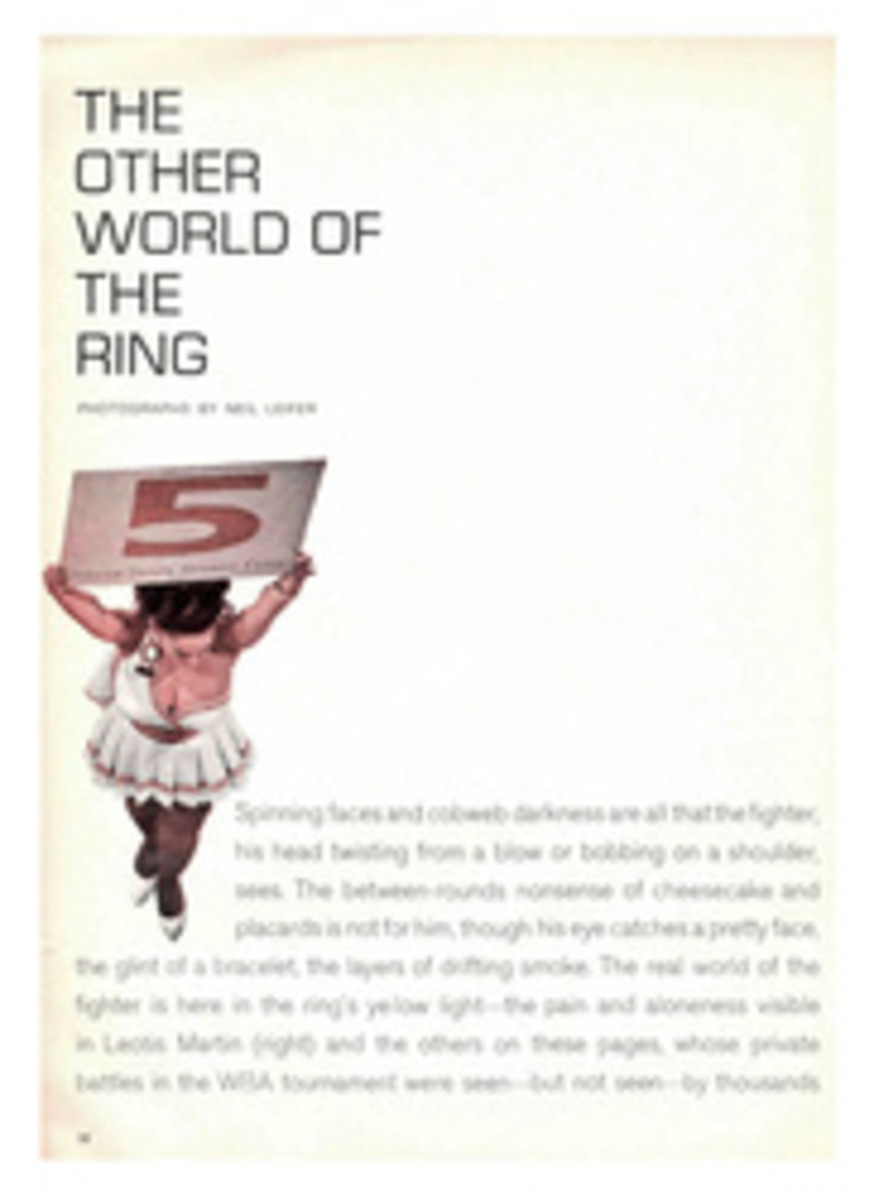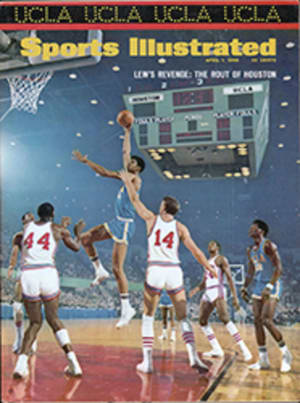
A HEAVY BLOW IN A WINDY CITY
The last cheer to echo inside Philadelphia's Spectrum faded nearly a month ago. Since then the new arena, which is built along the clean, if uninspired, lines of a six-story sardine can, has sat vacant and silent on the sullen, windswept flats of South Philadelphia (where once, coincidentally, the city dumped its garbage). Inside the building, where both the NBA 76ers and the NHL Flyers pulled big, noisy crowds all winter, there is now only the sound of raindrops leaking down on some of the 15,000-plus seats and the whisper of wings as pigeons soar past the blacked-out scoreboard. It is gloomy, all right.
But that is nothing compared to the shroud that has fallen over the Philadelphia sports fan this week as he looks on glum and helpless while his basketball and hockey teams—potential champions both—charge into the most frenzied and profitable moments of their seasons without a roof to call their own. The 76ers are holding their home playoffs in the church-basement atmosphere of Convention Hall (circa 1931) or Penn's Palestra. The team has lost $100,000 since the Spectrum closed, and it will sue—somebody. Meanwhile the Flyers, the probable losers of $400,000 or so, but insured, are completing their first-year charge to the NHL Western Division title on the alien ice of New York and Quebec City.
All of this chaos springs from an ill wind that blew off the roof of the Spectrum and ultimately whipped up a ruinous tempest involving 1) a brash and maybe bankrupt millionaire, 2) a 35-year-old personal feud between two old-line Philadelphia giants and 3) a political struggle between a desperately worried Democratic mayor and an intense young Republican district attorney. The 76ers and the Flyers, innocent victims both, find themselves dangling among the structural mediocrities of the Spectrum, a plethora of controversial personalities and some kick-'em-in-the-gut political infighting.
The Spectrum was built by the whiz-kid millionaire-owner of the Philadelphia Eagles, 41-year-old Jerry Wolman. The city had been bickering for 25 years about putting up a new indoor stadium, but Wolman was accustomed to much swifter results. In early 1966 he promised that he would fling up an arena in just 16 months. In fact, it had to be completed by September 1967 or Philadelphia would lose its bid for a new NHL franchise. The deal was that the city would donate six acres of land, Wolman would underwrite construction and, when the Spectrum was completed, title for the building would go to the city, with Wolman's enterprises renting the place for 50 years at $15,000 a year.
Unfortunately, Wolman began to run out of money before the Spectrum was finished. Even now the interior walls are raw cement, because there is no money to paint them. To save some cash, Wolman had to get a building-code variance (perfectly legal) on the roofing material, but when the place opened the roof leaked. There is a paucity of lavatories, no clocks and no lobby. Nonetheless, the Spectrum was finished on time, Philadelphia did get its hockey team and everyone agreed that, despite its Spartan decor, the new arena was a splendid place to watch indoor spectaculars.
Then came the black afternoon of February 17. About 1:45 p.m. a happy crowd of 11,000 was settling down in the Spectrum's comfy burnt-orange seats to see the Ice Capades. A fierce gale was blowing that day, and suddenly it gusted with such force that it created a vacuum across the 100,000-square-foot expanse of roof. The laws of physics being what they are, a large segment of roof covering was sucked up and sent flapping down to the parking lot. Inside, the horrified crowd heard a thunderous roar, and suddenly there was light through the inner metal skin of the ceiling. Immediately, perhaps while the roof was still in the air, the Ice Capades band struck up a tune to calm the crowd: Off We Go into the Wild Blue Yonder. There was no panic as the people filed out.
Later everyone agreed that a patch on the roof should suffice for the time being and, after a short shutdown, the Spectrum was back in business. But the patch did not suffice, and on the morning of March 1 that South Philly devil wind tore off some more roofing. This time Mayor James H. J. Tate himself came out from City Hall, clambered cautiously up the steel ladders to the roof, surveyed the damage and descended—crimson-faced and puffing—to announce that the Spectrum was closed for repairs. Indefinitely.
Even the most fanatic of Philadelphia sports followers agreed that it was in the public interest to close the Spectrum until the roof was fixed. But how long does it take to fix a roof? Maybe 10 days, except when it becomes a politically oriented roof. That kind can take months.
Even a man as soft-spoken as Jack Ramsay, the general manager of the 76ers, has finally gotten angry over City Hall's vacillations. "It would seem to me," he said last week, attempting to be as tactful as possible, "that we have had an unusual and unaccountable delay in making progress." But a lot of Philadelphians suggest that the delay isn't all that unaccountable.
For example, it is generally agreed that a significant cause of the Spectrum's postgale problems is that responsible old Republican newspaper, The Philadelphia Inquirer, which began editorializing for a shutdown immediately after the first blowoff. Righteous concern? A courageous crusade for safety? Absolutely. But many observers of the City of Brotherly Love also see behind those Inquirer editorials the flames of a delicious old feud between two major-league Philadelphians—Walter Annenberg, the passionately Republican publisher of the Inquirer, and Matthew McCloskey, fervent Democrat, former Ambassador to Ireland and multimillionaire contractor whose firm put up the Spectrum. Bad blood between the two dates back to the Roosevelt days, when McCloskey was an enormously successful fund-raiser for F.D.R. and the Annenberg papers were savage critics of Roosevelt. Ever since, the Inquirer has been quick to assail most anything associated with Old Matt.
It has had quite a few opportunities. In 1964 McCloskey's firm was sued by the Federal Government for faulty work in a Boston VA hospital. In 1965 McCloskey pulled black headlines during the Senate's investigation into Bobby Baker's deals when he was accused of making a party payoff in return for the D.C. Stadium contract. And it was McCloskey's firm that put up the highest-priced Washington white elephant of them all—the $87 million Rayburn Building on Capitol Hill.
Whatever its basic motive, that first Inquirer editorial drew little reaction. But when parts of the Spectrum roof flipped again on March 1, Mayor Tate had no choice: a shutdown was necessary. In addition, given the early Inquirer editorial, it was clear that, since he was a Democrat anyway, Tate just might face public assassination by newsprint if he took any hasty action. As a result, Tate insisted that the highbrow scientists of the Franklin Institute must test, test and retest—partly in a wind tunnel—any new roofing proposal for the Spectrum.
It was at about this point that Arlen Specter, the city's Republican district attorney and an extremely serious-minded young politician, entered the Spectrum picture. Not so coincidentally, Specter had been beaten—by a scant 11,000 votes—by Mayor Tate in a bitter election campaign last November, and it does not take a Ph. D. in political science to guess that in Philadelphia what is poison for James Tate is sugar-rock candy for Arlen Specter.
When the roof went the second time Specter reached for the candy. He sent his own investigators to the scene, probing and prodding for skulduggery. He knew that both Wolman and McCloskey had contributed nicely to Tate's campaign, and there is always grist for the political treadmill in such a situation. Eventually the district attorney discovered that 1) the Spectrum did not have the proper building permits when it was under construction, and 2) it did not—and does not today—have the necessary permit to occupy the building. This did not conform to the letter of the law—not at all, and there were headlines. Specter hinted at sinister doings at City Hall. More headlines. Specter said a dangerously slipshod inspection job might have been done at the Spectrum, and he said lie-detector tests might be a grand idea. Many, many more headlines.
At this point the Spectrum management quite properly reminded Philadelphia that the job had been rushed—with everyone's knowledge—to assure the NHL franchise. "If we'd followed every damn semicolon," said Hal Freeman, president of the Spectrum, "it would have taken three years to finish the place. Everyone knew there would be shortcuts. But we've passed every inspection required, as far as I know."
Nevertheless, if Mayor Tate had been proceeding with careful deliberation before Specter's revelations, he now went into a state of all-but-paralyzed caution. And thus, although workmen began pulling off the Spectrum roof for replacement last week, there was still a most intricate technical—and political—question at City Hall about precisely what kind of metal fasteners should be used, if any, to hold down the surface. That, too, was up to the Franklin Institute, and though it has no political horses to shoe, it does have an admirable scientific reputation to protect and could scarcely be expected to hurry its decision.
So there stands the Spectrum—dormant. And there play the 76ers and the Flyers—elsewhere. And there suffer thousands of Philadelphia fans—locked out. True, the gales still blow strong across the flats, but the suspicion is rising that the windiest ills of all in the Spectrum affair are those from the caves of politicians.
PHOTO
With part of the Spectrum's roof gone, men stand on its inner ceiling to assess damage.

